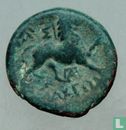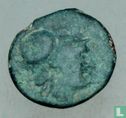

Enlarge image


Catalogue information
LastDodo number
7238419
Area
Coins
Title
Massalia, Gaul (ancient Greco-France) AE17 hemiobol 200-100 BCE
Country
Face value
Year
-150
Variety / overstrike
Head of State
Type
Designer
Series
Theme
Gold- or silver content
Weight
2.7
Diameter
17
Thickness
Punch
Shape
Obverse
MESSALIHTWN PA
Reverse
Edge
Privy mark
Mint mark
Number produced
Krause and Mishler number
Catalogue number
Unknown variant; SNG Cop 809-817, SNG Munich 377, Depeyrot 31, Monnaies II 77, De La Tour 1673,
Details
Rev; head of Athena right, in Corithian helmet
Obv; lion walking right, with raised paw; & "PA" monogram below.
Before Greece gained preeminence in the Gulf of Lion, trade was mainly handled by Etruscans and Carthaginians. The Greeks of Massalia had recurrent conflicts with Gauls and Ligurians of the region, and engaged in naval battles against Carthaginians in the late 6th century and probably in 490 BC, and soon entered into a treaty with Rome.
Massalia (modern-day Marseille) may have been less an isolated Greek city, and more a mini-Empire of its own along the coast of southern Gaul by the fourth century. Massalia may have had over twelve cities in its network in France, Spain, Monaco and Corsica, including other cities that still exist today: Nice, Antibes, Monaco, Le Brusc, Agde, and Aleria.
Massalia's empire may have been a scattered group of cities connected by the sea and rivers, which focused on trade, rather than agricultural territory, like other mini-empires (ancient Phoenicia or medieval Venice).
Greek Marseille may even have eventually become a center of culture which drew some Roman parents to send their children there to be educated. According to earlier views, a purported Hellenization of Southern France prior to the Roman Conquest of Transalpine Gaul is thought to have been largely due to the influence of Massalia.



